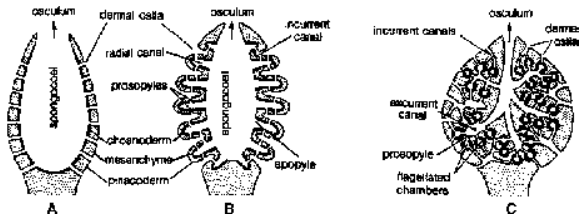
Canal System and Skeleton
Classification of Animals Non Chordates of Class 11
Canal System
Consists of interconnected chambers, canals and their openings lined by choanocytes or flagellated collar cells. Maintains current of water throughout the sponge, helps in nutrition, exchange of respiratory
gases and elimination of excretory products. Canal system is also called life line of sponge.
Types of Canal System
1. Ascon type (Asconoid)
Simplest type
Ostia (incurrent pores) open directly into spongocoel which leads into osculum (excurrent pore)
ex: Leucosolenia.
2. Sycon type (Syconoid)
Sponge wall thick and folded, more complex than Ascon type.
(i) Radial canals : Free from one another; water from outside passes through outer ostia into radial canals and then into spongocoel through internal ostia.
(ii) Walls of adjacent radial canals fuse to produce dermal cortex, gastric cortex and incurrent canals.

Fig. Canal system of sponges : A. Ascon type, B. Simple sycon type, C. Leucon type
3. Leucon type (Leuconoid) :
Sponge wall thick with extensive dermal and gastric cortex.
Dermal pores open into incurrent canals either directly or through large hypodermal spaces.
Incurrent canals irregular and branched.
Radial canals form clusters of flagellated chambers.
Excurrent canals lead either into excurrent spaces or spongocoel. ex : Spongilla
4. Rhagon type
Found in Demospongiae, derived from Rhagon larva.
Skeleton
Almost all sponges possess a skeleton found embedded in mesenchyme; may be spicules or spongin fibres.
1. Spicules : secreted by scleroblasts; and are of following types:
(a) Monaxon : Having one axis.
(i) Monactinal : Growth takes place in one direction only.
(ii) Diactinal : Growth occurs in both direction.
(iii) Amphidisc : Disc present at both ends.

Fig. Spicules and Spongin : 1. Monactinal monaxon, 2. Diactinal monaxon, 3. Tetraxon, 4. Triradiate,
5. Anphidisc, 6. Hexactinal triaxon, 7. Polyaxons, 8. Spongin fibres
(b) Tetraxon : Spicules with four rays.
Triradiate : When one of the four rays is lost
(c) Triaxon : Having 3 axis, producing 6 rays hence, hexactinal.
(d) Polyaxon : With several equal rays.
Sponges are not found in cold water. These flourish best in warm shallow water.
